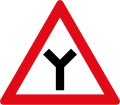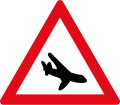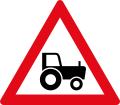It has been suggested that this article be merged with Road signs in Eswatini , Road signs in Namibia , Road signs in South Africa , List of road signs in Tanzania and Road signs in Zambia to Road signs in the Southern African Development Community . (Discuss) Proposed since February 2025. |
This article needs additional citations for verification .(December 2023) |

Road signs in Botswana are based on the SADC Road Traffic Signs Manual, [1] [2] [3] a document designed to harmonise traffic signs in member states of the Southern Africa Development Community.
Contents
- Gallery
- Priority signs
- Mandatory signs
- Prohibitory signs
- Warning signs
- Guidance signs
- Information signs
- See also
- References
A white background signifies the sign is permanent, while a yellow background signifies that the sign is temporary. Warning signs are an upwards-pointing red triangle and black pictogram describing the danger or obstruction. Speed limit signs are a red circle with the limitation in black. Botswana drives on the left.




































































































































































































